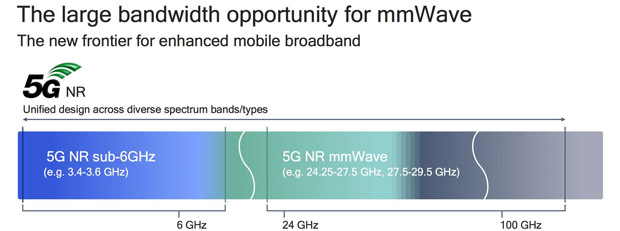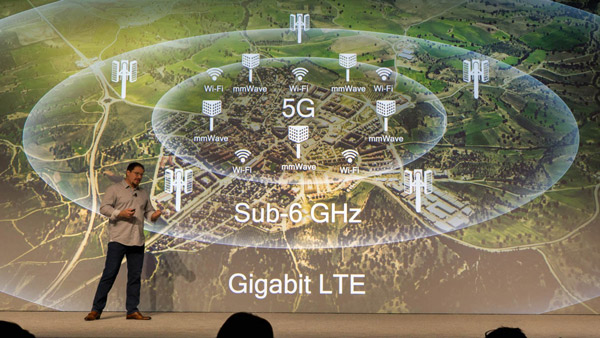Learn about mmWave and Sub-6GHz, 2 different bands of 5G network
Basically, 5G includes 2 frequency bands with different operating frequencies including: 5G sub-6GHz (also abbreviated sub-6), and mmWave (milimeter wave). 5G can be deployed in one or both of these frequency bands, depending on the choice of each country.
Higher frequencies mean faster speeds
mmWave : Has a frequency range from 30GHz to 300GHz, used for high-speed wireless connectivity standards such as Wi-Fi 802.11ad. The US Federal Communications Commission (FCC) and many companies choose mmWave to deploy 5G in the future. Then, users can connect everything quickly, stream 4K videos straight to the phone, experience AR VR content with mobile connectivity .

sub-6 : Has lower operating frequency, below 6GHz. Currently, the sub-6 range is being used for the wifi standards that we are still using, such as 802.11b, 802.11n, 802.11ac . In addition, the current 4G LTE network infrastructure includes 600MHz, 700MHz, 800MHz and 1200MHz also operate in the sub-6 range.
The higher the frequency, the less likely it is to penetrate and the shorter the transmission distance. Qualcomm said it is sometimes enough to just use a hand to block the phone, making it impossible to receive a signal. When the frequency is reduced, the waves travel farther (even many kilometers) but the transmission speed is lower.
Therefore, the new 5G includes both high and low frequency bands to be able to select the frequency range used for each situation.
Qualcomm said that the mmWave will be deployed in the inner city, where broadcasting stations (BTSs) can be easily installed to ensure high speed when multiple devices connect at the same time. In suburbs and more remote areas, operators will switch to sub-6. And 4G LTE will be the choice for further regions.

Qualcomm, thanks to the application of new technology, has succeeded in developing the 5G compatible modem and antenna. At the beginning of the study, antennas received 5G waves as large as a server, then gradually reduced to a device as big as a phone. And by the end of 2018, 2018 Qualcomm scaled this antenna system up with the tip of the little finger. Qualcomm's 5G antenna chip can be compatible with both high and low frequency bands.
Phones that want to use 5G will need to integrate an antenna chip as a transceiver and Snapdragon X50 chip as a receiver and signal processing modem.
The FCC is currently working with network operators to 'unlock mobile bandwidth and the potential of unregistered frequency bands on 24GHz' to enable faster deployment of 5G civilian applications. .
The choice varies from country to country

Qualcomm said that the US chose to deploy both Sub-6 and mmWave bands, currently only a few dozen major cities have been implemented. In Europe, Sub-6 will appear in the second half of 2019. China and Australia only focus on Sub-6, while Japan and Korea choose to support both.
Currently, the Motorola Z3 with a back-mounted module is the only phone that can use 5G, in the future, 5G will be integrated directly into the phone. Next year promises to be the year of 5G phones, let's wait and see what special 5G smartphones are.
See more:
- Vietnam will officially test 5G network in 2019
- China is about to develop 6G network, 10 times faster than 5G, 200 times more than 4G
- The difference between 2.4GHz and 5GHz Wi-Fi
- The way that 5G will change Internet connection in your home
You should read it
- Qualcomm unveiled the third-generation 5G Modem-RF system Snapdragon X60
- The 2019 iPhone uses new type antennas, improving cellular signal reception in the home
- How to replace WiFi antenna on wireless router
- Why is Wi-Fi on the computer always catching better on the phone?
- The 5G concept on Android 11 will be more 'troublesome' than you might think
- Discovering 'alien antenna' on the Moon?
 Microsoft developed Windows 10 Lite operating system, a small version that actually runs on mobile chips
Microsoft developed Windows 10 Lite operating system, a small version that actually runs on mobile chips Apple officially released iOS 12.1.1 update with many new features
Apple officially released iOS 12.1.1 update with many new features Free version of Counter-Strike: Global Offensive complete, adding survival mode 'Danger Zone'
Free version of Counter-Strike: Global Offensive complete, adding survival mode 'Danger Zone' Stories behind .unicorn, .ninja and other strange domain names
Stories behind .unicorn, .ninja and other strange domain names Snapdragon 8cx: The world's first 7nm chipset for PC, supports Windows 10 Enterprise, connects 2 4K monitors
Snapdragon 8cx: The world's first 7nm chipset for PC, supports Windows 10 Enterprise, connects 2 4K monitors Vietnam will officially test 5G network in 2019
Vietnam will officially test 5G network in 2019